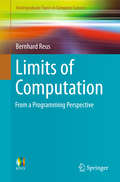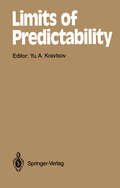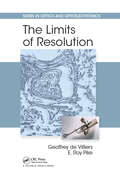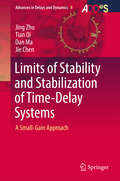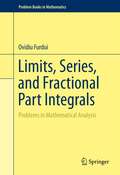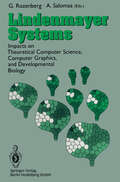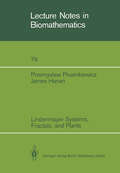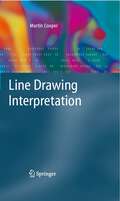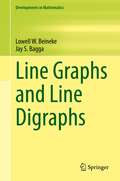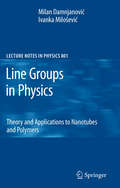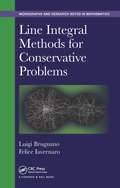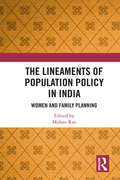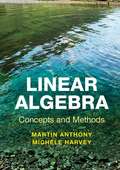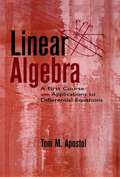- Table View
- List View
Limits of Computation: From a Programming Perspective (Undergraduate Topics in Computer Science #0)
by Bernhard ReusThis textbook discusses the most fundamental and puzzling questions about the foundations of computing. In 23 lecture-sized chapters it provides an exciting tour through the most important results in the field of computability and time complexity, including the Halting Problem, Rice's Theorem, Kleene's Recursion Theorem, the Church-Turing Thesis, Hierarchy Theorems, and Cook-Levin's Theorem. Each chapter contains classroom-tested material, including examples and exercises. Links between adjacent chapters provide a coherent narrative.Fundamental results are explained lucidly by means of programs written in a simple, high-level imperative programming language, which only requires basic mathematical knowledge. Throughout the book, the impact of the presented results on the entire field of computer science is emphasised. Examples range from program analysis to networking, from database programming to popular games and puzzles. Numerous biographical footnotes about the famous scientists who developed the subject are also included."Limits of Computation" offers a thorough, yet accessible, introduction to computability and complexity for the computer science student of the 21st century.
Limits of Predictability (Springer Series in Synergetics #60)
by Yurii A. KravtsovOne of the driving forces behind much of modern science and technology is the desire to foresee and thereby control the future. In recent years, however, it has become clear that, even in a deterministic world, there is alimit to the accuracy with which we can predict the future. This book details, in a largely nontechnical style, the extent to which we can predict the future development of various physical, biological and socio-economic processes.
The Limits of Resolution (Series in Optics and Optoelectronics)
by Geoffrey de Villiers E. Roy Pike"This beautiful book can be read as a novel presenting carefully our quest to get more and more information from our observations and measurements. Its authors are particularly good at relating it." --Pierre C. Sabatier "This is a unique text - a labor of love pulling together for the first time the remarkably large array of mathematical and statistical techniques used for analysis of resolution in many systems of importance today – optical, acoustical, radar, etc…. I believe it will find widespread use and value." --Dr. Robert G.W. Brown, Chief Executive Officer, American Institute of Physics "The mix of physics and mathematics is a unique feature of this book which can be basic not only for PhD students but also for researchers in the area of computational imaging." --Mario Bertero, Professor, University of Geneva "a tour-de-force covering aspects of history, mathematical theory and practical applications. The authors provide a penetrating insight into the often confused topic of resolution and in doing offer a unifying approach to the subject that is applicable not only to traditional optical systems but also modern day, computer-based systems such as radar and RF communications." --Prof. Ian Proudler, Loughborough University "a ‘must have’ for anyone interested in imaging and the spatial resolution of images. This book provides detailed and very readable account of resolution in imaging and organizes the recent history of the subject in excellent fashion.… I strongly recommend it." --Michael A. Fiddy, Professor, University of North Carolina at Charlotte This book brings together the concept of resolution, which limits what we can determine about our physical world, with the theory of linear inverse problems, emphasizing practical applications. The book focuses on methods for solving illposed problems that do not have unique stable solutions. After introducing basic concepts, the contents address problems with "continuous" data in detail before turning to cases of discrete data sets. As one of the unifying principles of the text, the authors explain how non-uniqueness is a feature of measurement problems in science where precision and resolution is essentially always limited by some kind of noise.
The Limits of Resolution (Series in Optics and Optoelectronics)
by Geoffrey de Villiers E. Roy Pike"This beautiful book can be read as a novel presenting carefully our quest to get more and more information from our observations and measurements. Its authors are particularly good at relating it." --Pierre C. Sabatier "This is a unique text - a labor of love pulling together for the first time the remarkably large array of mathematical and statistical techniques used for analysis of resolution in many systems of importance today – optical, acoustical, radar, etc…. I believe it will find widespread use and value." --Dr. Robert G.W. Brown, Chief Executive Officer, American Institute of Physics "The mix of physics and mathematics is a unique feature of this book which can be basic not only for PhD students but also for researchers in the area of computational imaging." --Mario Bertero, Professor, University of Geneva "a tour-de-force covering aspects of history, mathematical theory and practical applications. The authors provide a penetrating insight into the often confused topic of resolution and in doing offer a unifying approach to the subject that is applicable not only to traditional optical systems but also modern day, computer-based systems such as radar and RF communications." --Prof. Ian Proudler, Loughborough University "a ‘must have’ for anyone interested in imaging and the spatial resolution of images. This book provides detailed and very readable account of resolution in imaging and organizes the recent history of the subject in excellent fashion.… I strongly recommend it." --Michael A. Fiddy, Professor, University of North Carolina at Charlotte This book brings together the concept of resolution, which limits what we can determine about our physical world, with the theory of linear inverse problems, emphasizing practical applications. The book focuses on methods for solving illposed problems that do not have unique stable solutions. After introducing basic concepts, the contents address problems with "continuous" data in detail before turning to cases of discrete data sets. As one of the unifying principles of the text, the authors explain how non-uniqueness is a feature of measurement problems in science where precision and resolution is essentially always limited by some kind of noise.
Limits of Stability and Stabilization of Time-Delay Systems: A Small-Gain Approach (Advances in Delays and Dynamics #8)
by Jing Zhu Tian Qi Dan Ma Jie ChenThis authored monograph presents a study on fundamental limits and robustness of stability and stabilization of time-delay systems, with an emphasis on time-varying delay, robust stabilization, and newly emerged areas such as networked control and multi-agent systems. The authors systematically develop an operator-theoretic approach that departs from both the traditional algebraic approach and the currently pervasive LMI solution methods. This approach is built on the classical small-gain theorem, which enables the author to draw upon powerful tools and techniques from robust control theory. The book contains motivating examples and presents mathematical key facts that are required in the subsequent sections. The target audience primarily comprises researchers and professionals in the field of control theory, but the book may also be beneficial for graduate students alike.
Limits, Series, and Fractional Part Integrals: Problems in Mathematical Analysis (Problem Books in Mathematics)
by Ovidiu FurduiThis book features challenging problems of classical analysis that invite the reader to explore a host of strategies and tools used for solving problems of modern topics in real analysis. This volume offers an unusual collection of problems — many of them original — specializing in three topics of mathematical analysis: limits, series, and fractional part integrals. The work is divided into three parts, each containing a chapter dealing with a particular problem type as well as a very short section of hints to select problems. The first chapter collects problems on limits of special sequences and Riemann integrals; the second chapter focuses on the calculation of fractional part integrals with a special section called ‘Quickies’ which contains problems that have had unexpected succinct solutions. The final chapter offers the reader an assortment of problems with a flavor towards the computational aspects of infinite series and special products, many of which are new to the literature. Each chapter contains a section of difficult problems which are motivated by other problems in the book. These ‘Open Problems’ may be considered research projects for students who are studying advanced calculus, and which are intended to stimulate creativity and the discovery of new and original methods for proving known results and establishing new ones. This stimulating collection of problems is intended for undergraduate students with a strong background in analysis; graduate students in mathematics, physics, and engineering; researchers; and anyone who works on topics at the crossroad between pure and applied mathematics. Moreover, the level of problems is appropriate for students involved in the Putnam competition and other high level mathematical contests.
Lindenmayer Systems: Impacts on Theoretical Computer Science, Computer Graphics, and Developmental Biology
by Grzegorz Rozenberg Arto SalomaaL systems are language-theoretic models for developmental biology. They wereintroduced in 1968 by Aristid Lindenmayer (1925-1989) and have proved to be among the most beautiful examples of interdisciplinary science, where work in one area induces fruitful ideas and results in other areas. L systemsare based on relational and set-theoretic concepts, which are more suitable for the discrete and combinatorial structures of biology than mathematical models based on calculus or statistics. L systems have stimulated new work not only in the realistic simulation of developing organisms but also in the theory of automata and formal languages, formal power series, computer graphics, and combinatorics of words. This book contains research papers by almost all leading authorities and by many of the most promising young researchers in the field. The 28 contributions are organized in sections on basic L systems, computer graphics, graph grammars and map L systems, biological aspects and models, and variations and generalizations of L systems. The introductory paper by Lindenmayer and J}rgensen was written for a wide audience and is accessible to the non-specialist reader. The volume documents the state of the art in the theory of L systems and their applications. It will interest researchers and advanced students in theoretical computer science and developmental biology as well as professionals in computer graphics.
Lindenmayer Systems, Fractals, and Plants (Lecture Notes in Biomathematics #79)
by Przemyslaw Prusinkiewicz James Hanan1-systems are a mathematical formalism which was proposed by Aristid 1indenmayer in 1968 as a foundation for an axiomatic theory of develop ment. The notion promptly attracted the attention of computer scientists, who investigated 1-systems from the viewpoint of formal language theory. This theoretical line of research was pursued very actively in the seventies, resulting in over one thousand publications. A different research direction was taken in 1984 by Alvy Ray Smith, who proposed 1-systems as a tool for synthesizing realistic images of plants and pointed out the relationship between 1-systems and the concept of fractals introduced by Benoit Mandel brot. The work by Smith inspired our studies of the application of 1-systems to computer graphics. Originally, we were interested in two problems: • Can 1-systems be used as a realistic model of plant species found in nature? • Can 1-systems be applied to generate images of a wide class of fractals? It turned out that both questions had affirmative answers. Subsequently we found that 1-systems could be applied to other areas, such as the generation of tilings, reproduction of a geometric art form from East India, and synthesis of musical scores based on an interpretation of fractals. This book collects our results related to the graphical applications of- systems. It is a corrected version of the notes which we prepared for the ACM SIGGRAPH '88 course on fractals.
Line graph example (Large Print)
by Rnib Bookshareline, graph, plot, X-axis, Y-axis, data, data line, ICT
Line graph example (UEB Contracted)
by Rnib Bookshareline, graph, plot, X-axis, Y-axis, data, data line, ICT
Line graph example (UEB Uncontracted)
by Rnib Bookshareline, graph, plot, X-axis, Y-axis, data, data line, ICT
Line graph (large print)
by RnibThis page shows a line graph. There is a locator dot shown, which will be at the top left, when the image is the correct way up. The Y-axis on the left of the page is the temperature in degrees Centigrade from below freezing to thirty degrees. It is numbered every ten degrees. There are horizontal gridlines going from the Y-axis every ten degrees. The X-axis at the bottom of the page shows the months of the year labelled with the first letter of the month. There are vertical gridlines from each month. The dashed data line (blue on large print) goes up and right from the bottom left corner to a peak, then down and right. It crosses a second data line twice. The second solid (red on large print) data line comes from the top left, crosses the first data line and then goes up and right, crossing the first data line again, to the top right of the graph.
A line graph (UEB contracted)
by RnibThis diagram shows a generic line graph. There is a locator dot shown, which will be at the top left of the page when the image is the right way up. The x-axis is labelled and goes from 0 to 5 at the bottom of the diagram. The y-axis is also labelled and goes from 0 to 8 to the left of the page. Each point on the y-axis has a dotted horizontal line extending across the page. There is a single line plotted on this graph, joining data points shown as dots. It starts in the bottom left and goes sharply up to the right. It then comes down, going up again to the right of the page.
Line graph (UEB contracted)
by RnibThis page shows a line graph. There is a locator dot shown, which will be at the top left, when the image is the correct way up. The Y-axis on the left of the page is the temperature in degrees Centigrade from below freezing to thirty degrees. It is numbered every ten degrees. There are horizontal gridlines going from the Y-axis every ten degrees. The X-axis at the bottom of the page shows the months of the year labelled with the first letter of the month. There are vertical gridlines from each month. The dashed data line (blue on large print) goes up and right from the bottom left corner to a peak, then down and right. It crosses a second data line twice. The second solid (red on large print) data line comes from the top left, crosses the first data line and then goes up and right, crossing the first data line again, to the top right of the graph.
Line graph (UEB uncontracted)
by RnibThis page shows a line graph. There is a locator dot shown, which will be at the top left, when the image is the correct way up. The Y-axis on the left of the page is the temperature in degrees Centigrade from below freezing to thirty degrees. It is numbered every ten degrees. There are horizontal gridlines going from the Y-axis every ten degrees. The X-axis at the bottom of the page shows the months of the year labelled with the first letter of the month. There are vertical gridlines from each month. The dashed data line (blue on large print) goes up and right from the bottom left corner to a peak, then down and right. It crosses a second data line twice. The second solid (red on large print) data line comes from the top left, crosses the first data line and then goes up and right, crossing the first data line again, to the top right of the graph.
Line Graphs and Line Digraphs (Developments in Mathematics #68)
by Lowell W. Beineke Jay S. BaggaIn the present era dominated by computers, graph theory has come into its own as an area of mathematics, prominent for both its theory and its applications. One of the richest and most studied types of graph structures is that of the line graph, where the focus is more on the edges of a graph than on the vertices. A subject worthy of exploration in itself, line graphs are closely connected to other areas of mathematics and computer science. This book is unique in its extensive coverage of many areas of graph theory applicable to line graphs. The book has three parts. Part I covers line graphs and their properties, while Part II looks at features that apply specifically to directed graphs, and Part III presents generalizations and variations of both line graphs and line digraphs.Line Graphs and Line Digraphs is the first comprehensive monograph on the topic. With minimal prerequisites, the book is accessible to most mathematicians and computer scientists who have had an introduction graph theory, and will be a valuable reference for researchers working in graph theory and related fields.
Line Groups in Physics: Theory and Applications to Nanotubes and Polymers (Lecture Notes in Physics #801)
by Milan Damnjanovic Ivanka MilosevicOver last decades low-dimensional materials are in focus of physics and chemistry as well as of material and other natural sciences. Like Vitaly Ginzburg has foreseen 30 years ago, low dimensionality offers physical phenomena and properties unseen in three-dimensional world. To see how thin ?lms and monomolecular layers realize such a prediction it suf?ces only to observe intensity of research devoted to recently synthesized graphene. Still, quasi-one-dimensional compounds are over long period established as the origin of the most important and most interesting discoveries of material science and solid state physics. To mention only deoxyribonucleic acid, the most important molecule in nature, and diversity of nanotubes and nanowires, the cornerstones of the present and future nanotechnology. Line groups, describing symmetry of quasi-one-dimensional materials, offer the deepest insight to their characteristic properties. Underlying many of the laws, they are very useful, but far from simple. This book is intended to explain them, their properties, and their most common applications. In particular, it is important to understand that the line groups are much wider class of symmetries than the well-known rod groups. While the latter describe only translationally periodical objects, line groups include symmetries of incommensurate periodical structures.
Line Integral Methods for Conservative Problems
by Luigi Brugnano Felice IavernaroLine Integral Methods for Conservative Problems explains the numerical solution of differential equations within the framework of geometric integration, a branch of numerical analysis that devises numerical methods able to reproduce (in the discrete solution) relevant geometric properties of the continuous vector field. The book focuses on a large
Line scales- Braille and Large Print (tactile)
by Adrian FarnsworthThese pages show different line scales, labelled in large print on the first page and braille on the second page.
The Lineaments of Population Policy in India: Women and Family Planning
by Mohan RaoIndia is the first country in the world to have an official programme for family planning that commenced in 1952. It has also seen a strong women’s movement to assert reproductive and contraceptive rights. This book brings to the fore several contestations and negotiations between public policy and the women’s movement in India. The comprehensive volume puts together key documents from archival records and authoritative sources, and traces the contours that have marked and defined the population policy in India as well as rights issues for women. A major intervention in the field, this book will be indispensable for scholars and researchers in public policy, public health, demography, gender studies, social policy, development studies, sociology, social justice, human rights, politics and those interested in the study of modern India.
The Lineaments of Population Policy in India: Women and Family Planning
India is the first country in the world to have an official programme for family planning that commenced in 1952. It has also seen a strong women’s movement to assert reproductive and contraceptive rights. This book brings to the fore several contestations and negotiations between public policy and the women’s movement in India. The comprehensive volume puts together key documents from archival records and authoritative sources, and traces the contours that have marked and defined the population policy in India as well as rights issues for women. A major intervention in the field, this book will be indispensable for scholars and researchers in public policy, public health, demography, gender studies, social policy, development studies, sociology, social justice, human rights, politics and those interested in the study of modern India.
Linear Algebra: Concepts And Methods (PDF)
by Martin Anthony Michele HarveyAny student of linear algebra will welcome this textbook, which provides a thorough treatment of this key topic. Blending practice and theory, the book enables the reader to learn and comprehend the standard methods, with an emphasis on understanding how they actually work. At every stage, the authors are careful to ensure that the discussion is no more complicated or abstract than it needs to be, and focuses on the fundamental topics. The book is ideal as a course text or for self-study. Instructors can draw on the many examples and exercises to supplement their own assignments. End-of-chapter sections summarise the material to help students consolidate their learning as they progress through the book.
Linear Algebra: A First Course with Applications to Differential Equations
by Tom M. ApostolDeveloped from the author's successful two-volume Calculus text this book presents Linear Algebra without emphasis on abstraction or formalization. To accommodate a variety of backgrounds, the text begins with a review of prerequisites divided into precalculus and calculus prerequisites. It continues to cover vector algebra, analytic geometry, linear spaces, determinants, linear differential equations and more.
Linear Algebra: A First Course with Applications to Differential Equations
by Tom M. ApostolDeveloped from the author's successful two-volume Calculus text this book presents Linear Algebra without emphasis on abstraction or formalization. To accommodate a variety of backgrounds, the text begins with a review of prerequisites divided into precalculus and calculus prerequisites. It continues to cover vector algebra, analytic geometry, linear spaces, determinants, linear differential equations and more.
